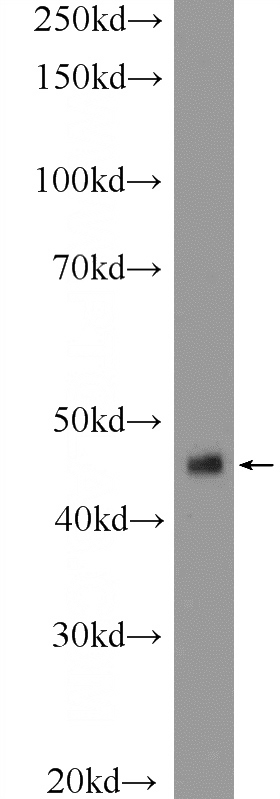-
Product Name
ING1 antibody
- Documents
-
Description
ING1 Rabbit Polyclonal antibody. Positive WB detected in mouse liver tissue, A375 cells. Observed molecular weight by Western-blot: 47 kDa
-
Tested applications
ELISA, WB
-
Species reactivity
Human,Mouse,Rat; other species not tested.
-
Alternative names
ING1 antibody; Inhibitor of growth protein 1 antibody; p24ING1c antibody; p33 antibody; p33ING1 antibody; p33ING1b antibody; p47 antibody; p47ING1a antibody
-
Isotype
Rabbit IgG
-
Preparation
This antibody was obtained by immunization of ING1 recombinant protein (Accession Number: NM_198219). Purification method: Antigen affinity purified.
-
Clonality
Polyclonal
-
Formulation
PBS with 0.1% sodium azide and 50% glycerol pH 7.3.
-
Storage instructions
Store at -20℃. DO NOT ALIQUOT
-
Applications
Recommended Dilution:
WB: 1:200-1:2000
-
Validations

mouse liver tissue were subjected to SDS PAGE followed by western blot with Catalog No:111790(ING1 Antibody) at dilution of 1:600
-
Background
ING1, also inhibitor of growth protein 1, is a 422 amino acid protein, which contains 1 PHD-type zinc finger and belongs to the ING family. ING1 localizes in the nucleus and interacts with TP53. It exsits as varous isoforms and isoform 1 is a 47 kDa protein. Isoform 2 is a 33 kDa protein and expressed in all normal tissues, as well as in all breast cancer and melanoma cell lines examined. ING1 cooperates with p53/TP53 in the negative regulatory pathway of cell growth by modulating p53-dependent transcriptional activation. It is implicated as a tumor suppressor gene.
Related Products / Services
Please note: All products are "FOR RESEARCH USE ONLY AND ARE NOT INTENDED FOR DIAGNOSTIC OR THERAPEUTIC USE"
